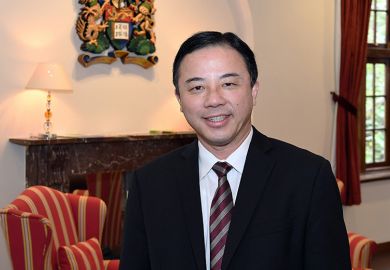Support staff are in the majority at 71 per cent of UK higher education institutions, analysis by Times Higher Education has revealed.
Universities’ 2013-14 returns to the Higher Education Statistics Agency on staff numbers reveal that support staff were the majority at 111 out of 157 institutions. They made up 60 per cent or more of all staff at 27 institutions, excluding obvious statistical anomalies.
The highest proportion – 85 per cent – was recorded by London Business School. Among larger institutions (defined for the purposes of the analysis as those with at least 500 academics), the highest proportion of support staff – 63 per cent – was recorded by the University of Bradford. The University of Wolverhampton had 62 per cent and Durham and Aberystwyth universities had 61 per cent. The overall national average was 53 per cent.
Brian Cantor, vice-chancellor of Bradford, said that the university had recently launched a 10-year development plan “designed to deliver the university’s new strategy to be one of the world’s best technology universities”, which would see both student and staff numbers grow.
“As part of this plan, the university will see a significant growth in the proportion of academic staff,” he said.
A spokesman for Durham said: “Our support structures are appropriately resourced to support our academic staff in departments, faculties and colleges, across a wide range of activities.”
A spokesman for Wolverhampton said that its high rate of professional services staff was explained by its multi-site location, which required duplication of services, as well as the “wider range of opportunities to students” it offered “as part of our commitment to widening access and participation to higher education”, and its emphasis on providing careers and student support.
“Additionally, unlike some other universities we do not contract out or outsource any aspect of our non-teaching function,” it added.
London Business School did not respond to a request for comment.
An army of administrators
Some academics have expressed concern about the rise in the proportion of administrators employed by universities in recent decades. In his 2011 book, The Fall of the Faculty: The Rise of the All-Administrative University and Why It Matters, Benjamin Ginsberg, a professor in the department of political science at Johns Hopkins University, said that the growth had pushed up costs and corrupted universities’ scholarly missions. In a 2011 interview with THE, he suggested comparing the ratio of academic to administration staff in individual institutions to highlight outliers.
Hesa figures are based on contract type, so do not include academics who take on administrative roles. They also include those with blue-collar jobs, such as tradespeople and machine operatives.
Kathryn Fowler, vice-chair of the Association off University Administrators, responds
When analysis is restricted to staff with white-collar jobs such as managers, “professionals” and “administrative and secretarial occupations”, London Business School remains the most administrative heavy institution, accounting for 79 per cent of its total staff. But the University of the Arts London rises to the top of the ranking of larger institutions, with 52 per cent, followed by the Open University with 51 per cent. The national average was 43 per cent.
In total, more than half of staff at 14 universities were doing white-collar administrative jobs.
The lean option
At the other end of the scale, the lowest proportion overall was recorded by the Guildhall School of Music and Drama, with 35 per cent. Of the larger institutions, the Institute of Cancer Research had the lowest proportion, with 37 per cent. Arts University Bournemouth was the only other institution with a figure of less than 40 per cent, while just over a third of institutions had figures of less than 50 per cent.
Meanwhile, 31 universities had less than 40 per cent of their staff employed in white-collar administrative jobs, and only 12 had more than 50 per cent. Among larger institutions, the lowest proportions were recorded by the Institute of Cancer Research (33 per cent) and the University of Cambridge (35 per cent).
THE also looked at the average cost of each administrative post, combining the data on staff numbers with Hesa figures on university expenditure on staff.
The highest average cost (£82,000) was recorded by the Guildhall School of Music, followed by the University of Cambridge (£79,000). Neither Guildhall nor Cambridge responded to requests for comment.
However, the average cost of such posts was higher than the average cost of academic posts in just 16 institutions.
The lowest average cost, £26,000, was recorded by University College Birmingham. Of the larger institutions, the lowest figure, £30,000, was recorded by Canterbury Christ Church University.
10 campuses with largest support staff
| Institution | Proportion of support staff (%) |
| University of Bradford | 63 |
| University of Wolverhampton | 62 |
| Durham University | 61 |
| Aberystwyth University | 61 |
| University of Sunderland | 60 |
| University of Bath | 60 |
| Keele University | 59 |
| Aston University | 59 |
| University of Reading | 59 |
| University of Essex | 59 |
10 campuses with smallest support staff
| Institution | Proportion of support staff (%) |
| Institute of Cancer Research | 37 |
| Ulster University | 41 |
| London School of Hygiene and Tropical Medicine | 41 |
| King’s College London | 42 |
| University College London* | 44 |
| London South Bank University | 44 |
| University of Oxford | 44 |
| Kingston University | 45 |
| Birkbeck, University of London | 45 |
| Coventry University | 45 |
10 lowest support-post costs
| Institution | Average cost (£) |
| Canterbury Christ Church University | 30,201 |
| University of Chester | 31,879 |
| Durham University | 32,728 |
| Edge Hill University | 32,735 |
| University of Wolverhampton | 32,741 |
| Keele University | 32,755 |
| Newcastle University | 32,775 |
| University of Aberdeen | 33,094 |
| University of St Andrews | 33,158 |
| Swansea University | 33,402 |
10 highest support-post costs
| Institution | Average cost (£) |
| University of Cambridge | 79,104 |
| University of the Arts London | 63,656 |
| University of East London | 56,880 |
| Cranfield University | 55,033 |
| University of Central Lancashire | 53,123 |
| Kingston University | 52,869 |
| University of Sussex | 52,545 |
| University of Oxford | 52,181 |
| City University London | 51,701 |
| King’s College London | 51,149 |
Download full data on percentages of support staff
* Data for UCL includes that for the Institute of Education, with which it merged last year
Notes: Data are based on Higher Education Statistics Agency figures for 2013-14 on staff numbers and university expenditure. The figures on staff numbers are full-time equivalents. Institutions with fewer than 500 academic staff are excluded from these tables in order to focus on mainstream universities
POSTSCRIPT:
Print headline: Faculty in minority at two-thirds of campuses
Register to continue
Why register?
- Registration is free and only takes a moment
- Once registered, you can read 3 articles a month
- Sign up for our newsletter
Subscribe
Or subscribe for unlimited access to:
- Unlimited access to news, views, insights & reviews
- Digital editions
- Digital access to THE’s university and college rankings analysis
Already registered or a current subscriber? Login






